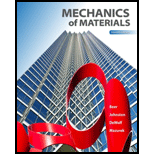
Concept explainers
(a)
Find the change in height and the change in volume of brass cylinder.
(a)
Answer to Problem 84P
The change in height of brass cylinder is
The change in volume of brass cylinder is
Explanation of Solution
Given information:
The young’s modulus E is
The poison ratio
The normal stress
Calculation:
Find the area of solid sphere as follows:
Here,
Substitute
Find the volume of solid sphere as follows:
Here,
Substitute
The normal stress
The normal stress
The normal stress
Write the expression of strain along y axis as follows:
Substitute 0 for
Substitute
Determine the change in height of brass cylinder using the relation:
Substitute
Thus, the change in height of brass cylinder is
Find the value of dilatation e using the relation:
Substitute 0 for
Substitute 0.33 for
Determine the change in volume of brass cylinder as follows:
Substitute
Hence, the change in volume of brass cylinder is
(b)
Find the change in height and the change in volume of brass cylinder when
(b)
Answer to Problem 84P
The change in height of brass cylinder when
The change in volume of brass cylinder when
Explanation of Solution
Calculation:
Find the value of
Write the expression of strain along y axis as follows:
Substitute 0.34 for
Determine the change in height of brass cylinder when
Substitute
Thus, the change in height of brass cylinder when
Find the value of dilatation e using the relation:
Substitute 0.34 for
Determine the change in volume of brass cylinder when
Substitute
Hence, the change in volume of brass cylinder when
Want to see more full solutions like this?
Chapter 2 Solutions
Mechanics of Materials, 7th Edition
- A block of wood having a volume of 0.034 m3 and weighing 300 N is suspended in seawater as shown. A wooden rod of length 3.4 m and cross-section of 2000 mm2 is attached to the weight and also to the wall. If the rod weighs 16 N, determine the angle θ for equilibrium.arrow_forwardThe block shown is made of a magnesium alloy for which E = 45 GPa and ν= 0.35. Knowing that σx=–180 MPa, determine (a) the magnitude of σy for which the change in the height of the block will be zero, (b) the corresponding change in the area of the face ABCD, (c) the corresponding change in the volume of the blockarrow_forwardThe 1021-kg uniform bar AB is suspended from two cables AC and BD each with cross-sectional area 472 mm2. Find the magnitude of P (in N) that can be safely applied to the bar if the stresses in AC and BD are limited to 110 MPa and 51 MPa, respectively. Express your answer in two decimal places.arrow_forward
- The 981-kg uniform bar AB is suspended from two cables AC and BD each with cross-sectional area 339 mm2. Find the location x (in mm) of P that can be safely applied to the bar if the stresses in AC and BD are limited to 119 MPa and 52 MPa, respectively. Express your answer in two decimal places.arrow_forwardA steel penstock has a 750-mm outer diameter and connects a reser-voir at A with a generating station at B. Knowing that the density of water is 1000 kg/m3 and that the allowable normal stress in the steel is 85 MPa, determine the smallest thickness that can be used for the penstockarrow_forwardThe aluminum rod AD is fitted with a jacket that is used to apply a hydrostatic pressure of 6000 psi to the 12-in. portion BC of the rod. Knowing that E=10.1* 106 psi and ν=0.36, determine (a) the change in the total length AD, (b) the change in diameter at the middle of the rod, determine the forces that should be applied to the ends A and D of the rod (a) if the axial strain in portion BC of the rod is to remain zero as the hydrostatic pressure is applied, (b) if the total length AD of the rod is to remain unchangedarrow_forward
- A fabric used in air-inflated structures is subjected to a biaxial loading that results in normal stresses ox = 18 ksi and oz = 24 ksi.Knowing that the properties of the fabric can be approximated as E = 12.6 x 10 psi and v = 0.34, determine the change in length of (a) side AB, (b) side BC, (c) diagonal AC.arrow_forwardA 5-kN tensile load is applied to a test coupon made from 1.6-mm flat steel plate (E = 200 GPa, v = 0.30). Determine the change in volume of the 50-mm gage lenght segment AB by computing the dilatation of the material. Determine the change in volume of the 50-mm gage length segment AB by subtracting the original volume of portion AB from its final volume.arrow_forwardDetermine the weight of the heaviest cylinder which can be placed in the position shown without exceeding a stress of 50 MN/m2 in the cable BC. Neglect the weight of the bar AB. The cross – sectional area of cable BC is 100mm2.arrow_forward
- In many situations it is known that the normal stress in a given direc-tion is zero. For example, σz= 0 in the case of the thin plate shown. For this case, which is known as plane stress, show that if the strains εx and εy have been determined experimentally, we can express σx, σyand εz as follows:arrow_forwardKnowing that the tensor has been adjusted so that the tension in the frame AD is 850 N, determine the internal forces at point K.Template: (In Kcd) F=750 N; M=170 Nm; V = 400 Narrow_forwardDetermine the value of w and P such that the resultant of the system is a downward force of magnitude 1200 N acting 3.6 m to the right of A. Determine the magnitude of the uniform load w. a.252 N/m b.646.1 N/m c.387.7 N/m d.553.8 N/marrow_forward
 International Edition---engineering Mechanics: St...Mechanical EngineeringISBN:9781305501607Author:Andrew Pytel And Jaan KiusalaasPublisher:CENGAGE L
International Edition---engineering Mechanics: St...Mechanical EngineeringISBN:9781305501607Author:Andrew Pytel And Jaan KiusalaasPublisher:CENGAGE L
